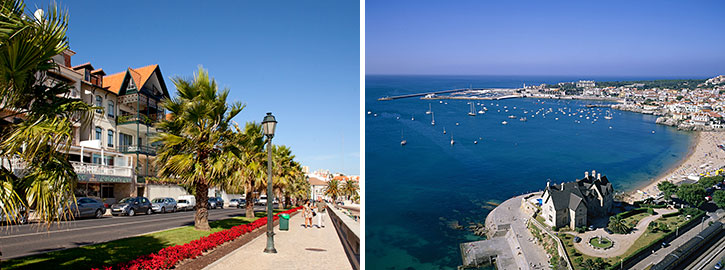         |
|
|
 Casino Estoril One of Europe's largest, it was the inspiration for the first of Ian Fleming's James Bond books, "Casino Royale." Known to give out the biggest weekly prizes in Europe, it also presents top international shows. During World War II, it was reputed to be a gathering spot for espionage agents, dispossessed royals, and wartime adventurers. Parque Estoril Parque Estoril, in the center of town, is a well-manicured landscape. At night, when it's floodlit, you can stroll amid the subtropical vegetation. The palm trees studding the grounds have prompted many to call it "a corner of Africa." At the top of the park sits the casino, which offers gambling, international floorshows, dancing, and movies. Tamariz Beach Across the railroad tracks is the beach, where some of the most fashionable people in Europe sun themselves on peppermint-striped canvas chairs along the Praia Estoril Tamariz. The beach is sandy, unlike the pebbly strand at Nice. The picturesque beach of Tamariz has a number of bars and restaurants, and a castle overlooking it that is owned by the royal family of Monaco.  Boca do Inferno Boca do Inferno (in English, 'hell's mouth') is an interesting rock formation on the coast west of Cascais. It is a bit tame when the sea is calm, but when the sea is rough, waves crash through a small hole and burst out the other side, which can be quite dramatic. The path may be closed for safety reasons if the waves get too high, but you get great views of the coastline and it's worth a look if you are in the area. There are also amenities close by (cafe, snack shop etc). Sintra Sintra is a town within the municipality of Sintra in the Grande Lisboa sub region of Portugal. Owing to its 19th-century Romantic architecture and landscapes, it has become a major tourist centre, visited by many day-trippers who travel from the urbanized suburbs and capital of Lisbon. In addition to the Sintra Mountains and Sintra-Cascais Nature Park, the parishes of the town of Sintra are dotted by royal retreats, estates, castles and buildings from the 8th-9th century, in addition to many buildings completed between the 15th and 19th century, including the Castelo dos Mouros, the Pena National Palace and the Sintra National Palace, resulting in its classification by UNESCO as a World Heritage Site in 1995. Fado Music Fado ("destiny, fate") is a music genre that can be traced to the 1820s in Portugal, but probably with much earlier origins. Fado historian and scholar Rui Vieira Nery states, "the only reliable information on the history of Fado was orally transmitted and goes back to the 1820s and 1830s at best. But even that information was frequently modified within the generational transmission process that made it reach us today." In popular belief, fado is a form of music characterized by mournful tunes and lyrics, often about the sea or the life of the poor, and infused with a characteristic sentiment of resignation, fatefulness and melancholia. However, although the origins are difficult to trace, today fado is regarded, by many, as simply a form of song that can be about anything, but must follow a certain structure. The music is usually linked to the Portuguese word saudade which symbolizes the feeling of loss (a permanent, irreparable loss and its consequent lifelong damage). Famous singers of fado include Amália Rodrigues, Dulce Pontes, Carlos do Carmo, Mariza, Mafalda Arnauth, António Zambujo, Ana Moura and Cristina Branco. 
|